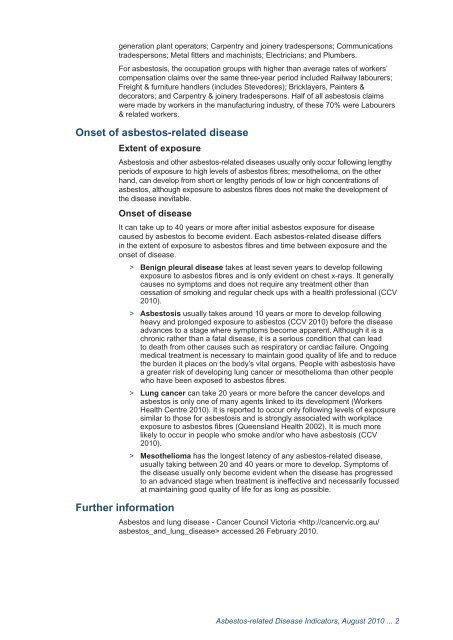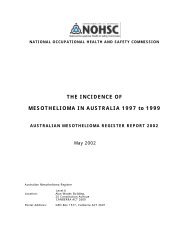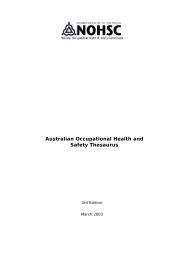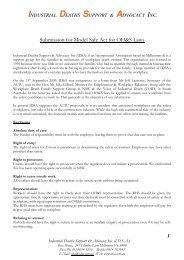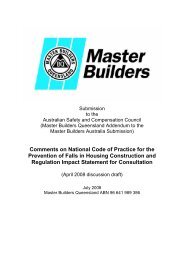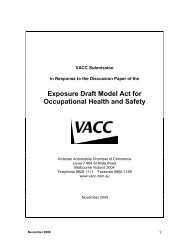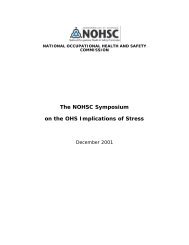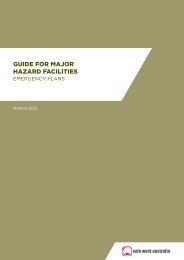Asbestos-related Disease Indicators.indd - Safe Work Australia
Asbestos-related Disease Indicators.indd - Safe Work Australia
Asbestos-related Disease Indicators.indd - Safe Work Australia
Create successful ePaper yourself
Turn your PDF publications into a flip-book with our unique Google optimized e-Paper software.
generation plant operators; Carpentry and joinery tradespersons; Communicationstradespersons; Metal fitters and machinists; Electricians; and Plumbers.For asbestosis, the occupation groups with higher than average rates of workers’compensation claims over the same three-year period included Railway labourers;Freight & furniture handlers (includes Stevedores); Bricklayers, Painters &decorators; and Carpentry & joinery tradespersons. Half of all asbestosis claimswere made by workers in the manufacturing industry, of these 70% were Labourers& <strong>related</strong> workers.Onset of asbestos-<strong>related</strong> diseaseExtent of exposure<strong>Asbestos</strong>is and other asbestos-<strong>related</strong> diseases usually only occur following lengthyperiods of exposure to high levels of asbestos fibres; mesothelioma, on the otherhand, can develop from short or lengthy periods of low or high concentrations ofasbestos, although exposure to asbestos fibres does not make the development ofthe disease inevitable.Onset of diseaseIt can take up to 40 years or more after initial asbestos exposure for diseasecaused by asbestos to become evident. Each asbestos-<strong>related</strong> disease differsin the extent of exposure to asbestos fi bres and time between exposure and theonset of disease.> Benign pleural disease takes at least seven years to develop followingexposure to asbestos fi bres and is only evident on chest x-rays. It generallycauses no symptoms and does not require any treatment other thancessation of smoking and regular check ups with a health professional (CCV2010).> <strong>Asbestos</strong>is usually takes around 10 years or more to develop followingheavy and prolonged exposure to asbestos (CCV 2010) before the diseaseadvances to a stage where symptoms become apparent. Although it is achronic rather than a fatal disease, it is a serious condition that can leadto death from other causes such as respiratory or cardiac failure. Ongoingmedical treatment is necessary to maintain good quality of life and to reducethe burden it places on the body’s vital organs. People with asbestosis havea greater risk of developing lung cancer or mesothelioma than other peoplewho have been exposed to asbestos fi bres.> Lung cancer can take 20 years or more before the cancer develops andasbestos is only one of many agents linked to its development (<strong>Work</strong>ersHealth Centre 2010). It is reported to occur only following levels of exposuresimilar to those for asbestosis and is strongly associated with workplaceexposure to asbestos fi bres (Queensland Health 2002). It is much morelikely to occur in people who smoke and/or who have asbestosis (CCV2010).> Mesothelioma has the longest latency of any asbestos-<strong>related</strong> disease,usually taking between 20 and 40 years or more to develop. Symptoms ofthe disease usually only become evident when the disease has progressedto an advanced stage when treatment is ineffective and necessarily focussedat maintaining good quality of life for as long as possible.Further information<strong>Asbestos</strong> and lung disease - Cancer Council Victoria accessed 26 February 2010.<strong>Asbestos</strong>-<strong>related</strong> <strong>Disease</strong> <strong>Indicators</strong>, August 2010 ... 2


